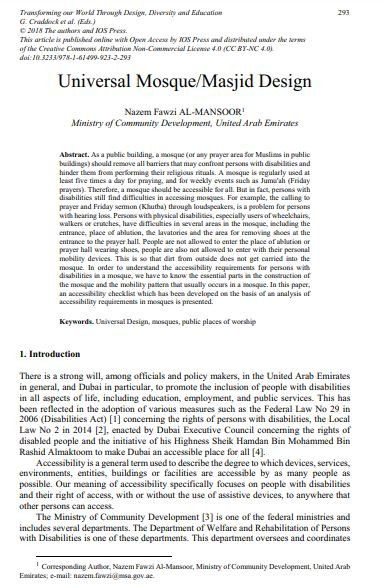
As a public building, a mosque (or any prayer area for Muslims in public buildings) should remove all barriers that may confront persons with disabilities and hinder them from performing their religious rituals. A mosque is regularly used at least five times a day for praying, and for weekly events such as Jumu’ah (Friday prayers). Therefore, a mosque should be accessible for all. But in fact, persons with disabilities still find difficulties in accessing mosques. For example, the calling to prayer and Friday sermon (Khutba) through loudspeakers, is a problem for persons with hearing loss. Persons with physical disabilities, especially users of wheelchairs, walkers or crutches, have difficulties in several areas in the mosque, including the entrance, place of ablution, the lavatories and the area for removing shoes at the entrance to the prayer hall. People are not allowed to enter the place of ablution or prayer hall wearing shoes, people are also not allowed to enter with their personal mobility devices. This is so that dirt from outside does not get carried into the mosque. In order to understand the accessibility requirements for persons with disabilities in a mosque, we have to know the essential parts in the construction of the mosque and the mobility pattern that usually occurs in a mosque. In this paper, an accessibility checklist which has been developed on the basis of an analysis of accessibility requirements in mosques is presented.
Al-Mansoor, Nazem Fawzi. “Universal mosque/masjid design.” In Transforming our World Through Design, Diversity and Education, pp. 293-298. IOS Press, 2018.
I agree to the terms outlined below:
You agree to upload and assign Mosqpedia Database the rights to use the content worldwide and in perpetuity across all current and future media platforms. Mosqpedia Database may edit, copy, adapt and translate your contribution.
The content will be distributed under the Creative Commons Attribution-Deed – Attribution-NonCommercial-NoDerivatives 4.0 International – Creative Commons
All data will be stored in line with data protection regulations.